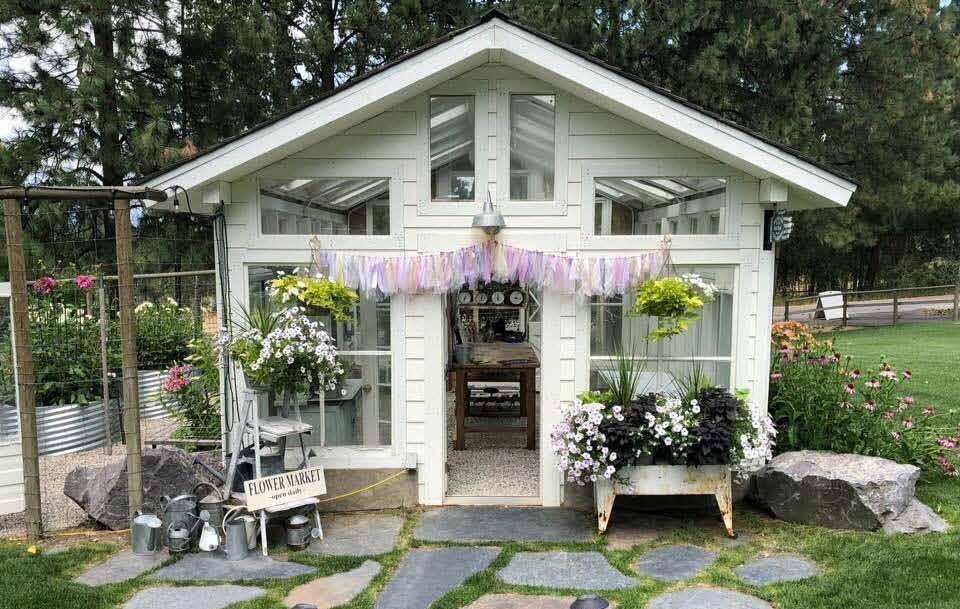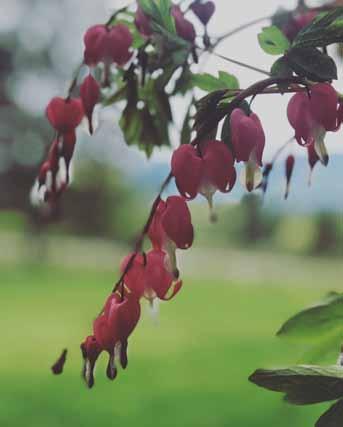
6 minute read
Flower farming
Agriculture Magazine, June 2020 - Page 5
photo Courtesy bleeding heart flower farm
Advertisement
Confessions of a middle-aged beginner flower farmer
Cindy Smith-Putnam Bleeding Heart Flower Farm
Start with a pandemic. Add a financial meltdown. Subtract access to capital. Divide by thin crop margins.
Most people would not do the math of 2020, then happily announce to their spouse of 38 years, “Hey, love. Let’s start a flower farm!”
Possibly, most people are smarter than me.
Exhibit A: Bleeding Heart Flower Farm, a small
Page 6 - Agriculture Magazine, June 2020
scale, high-intensity cut flower operation north of Stevensville we’ve just launched, bringing a great big little dream to life.
Considering the idea, I listed the “Pros”: • Lifelong gardener and flower geek • Small greenhouse • Existing wedding business • Lawn and a little timberland • Realignment of life priorities in the 3rd Quarter • And a husband who didn’t divorce me when I asked for help getting started. A little tree-falling, stump-excavating, deer-fencing, row-tilling, trellisbuilding, irrigation-laying, cold processing-spacebuilding sort of help. In his spare time. Like a good weekend project, only the opposite.
Under “Cons,” I wrote… well. Nothing. Cons are overrated. I avoided eye contact with cons.
Using my best reasonable-and-confident voice, I promised not to plunge us into crippling debt, while wearing the high ponytail and work boots he likes and wafting around pumpkin chocolate chip cookies. He couldn’t resist my shameless Wife
photo Courtesy bleeding heart flower farm

Super-Powers, and so far, he hasn’t turned me into compost by running me through the chipper. But it’s been mentioned.
For Big Ag readers eye-rolling about calling our itty-bitty operation a “farm,” me and my imposter syndrome understand. And fair point: we are micro-farming on less than two acres.
What we lack in ground, we make up for in diversity, planting more than 100 crop types and 15,000 plants we started from seed, tuber, bulb, corm, rhizome or cutting. Each species has its own quirks and wants something different from this aspiring farmer.
So far, so good. The field is full of seasonal thrillers, spillers, and fillers, oh my! Some seed crops are so easy, they practically grow themselves, and bulbs just want a good hole, while vines want to climb.
Other crops are tricky, with seeds tiny as dust specks, like snapdragons and foxglove, or super finicky germinators, like larkspur and buplereum. But my true nemesis? Bells of Ireland. I stratified.
I started seeds cold and dark. Warm and light. Moist and dry. In a box, with a fox, on a plane, in a train, on my head, in my bed. Finally defeated, I flung them on a snowbank and withheld my attention other than occasional karate kicks to the tray and bursts of cuss words. Lo and behold, 72 Bells of Ireland seedlings popped like popcorn. Masochists, evidently.
I’ve (mostly) kept my no-debt promise, so our Year 1 equipment is pretty sparse, consisting of baling twine, T-posts, weed fabric, and a loud lumbering beast of a 1979 walk-behind tiller that drags and bucks my poor husband all over creation as he hangs on for dear life by handlebars resembling ape hangers on a Hell’s Angels choppers. He assures me it is all far less enjoyable than a motorcycle joy-ride and we have named her “Killer Tiller.” Our Germination Facility (normal people call it “the garage”) is an electrician’s nightmare of extension cords, heat mats, thermostats and shop lights. Our biggest spends this first season were fertility and soil structure (cow poo from Hul’s) and drip irrigation.
Agriculture Magazine, June 2020 - Page 7
As expected and contrary to Instagram, it’s not all dreamy frolicking through petaled fields in fresh-starched gingham aprons with songbirds perched on my fingers chirping tra-la-la. This is row cropping, with baked-potato-sized-rock-picking, rotten fish emulsion spraying, pulling weeds by hand, covered in dirt, mosquito bites and sunscreen. “Sweaty & Stinky” is my new signature fragrance. And instead of consistently and harmoniously working with Mother Nature, more often I’m arguing with her. “Hurry up, already! Today! Sheesh.”
As for customers and sales, we are working hard for more of both, but keeping things simple to start: Hamilton Farmer’s Market, subscription bouquets in our flower CSA, and DIY buckets for brides.
A few things this Beginner Farmer has learned so far: • Voles are demon vermin from hell despite their cute little hands/paws/scoop shovels, and now I completely understand the motivation of Bill Murray’s character in Caddyshack.
june 2017 MAGAZI n e september 2017 m AGAZIN e In this issue Local produce program Blueweed Mulching with hay and more! March 2017 M a G a ZINE

In this issue Polyculture Goat lice, 4-H and more! september 201 8 m AGAZIN e In this issue Local economic opportunity Cheat grass 4-H leaders and more! In this issue Manged intensive grazing Sugar beet history Raising hogs and more!
june 2019
MAGAZINE
A special publication by the Ravalli Republic.
Look for the next issue September 2020
Page 8 - Agriculture Magazine, June 2020
• Ranunculus are just like my Grandma Marjorie: always too hot or too cold. • My co-workers (Bo the smart trusty Border Collie and Buddy the dramatic emotional Chiweenie) are totally unproductive, agriculturally speaking. Yet, they are valuable farm assets: supportive, friendly, attentive to supply chain issues (Annie the UPS driver) and vigilant with facility security (the local deer). Also: they never once reported my tirades against the Bells of Ireland to HR.
On the farm, there is a maddening, relentless sense of being behind. I address it with selfsoothing mantras: “In nature, nothing is rushed, yet everything is accomplished.” Then, since I’m already talking to myself in a field like a crazy person, I go ahead and snap back, “Right, but nature doesn’t have to pay the bills.” Don’t think I have completely lost it, but verging on flower farm fever.
In a nutshell and all seriousness, what I am learning about farming is everything. Failing. Succeeding. Feeling my 54-year-old body growing stronger. And overflowing with gratitude for it all.
In the rows, in the quiet, I think a lot. I dream of low tunnels and hoop houses and season extension. I yearn for scholarships to floristry workshops, expanding the farm footprint, farming flowers at my parents’ place down the road--cover your eyes, Mom and Dad. I dream of finding new customers who become new friends.
And I dwell in deep thanks for this season of life and its long hours in nature. I get a lump in my throat for work that allows me to look after my aging parents with the same devotion they’ve given me. And I thank my dumb luck to have married Greg, my Great Falls high school sweetheart all those years ago, who is still my Steady Eddie nodding and encouraging me to do hard things. Each day is different, but the rhythm has become familiar: solid, honest, authentic work with a rare photo Courtesy bleeding heart flower farm and powerful payoff—the opportunity to offer beauty and kindness to the world, in the form of flowers. Just when the world really needs more kindness and beauty, I am in a position to give it. How great is that?
Farming is optimistic and generous. It’s the hope the seed will grow, and the belief that the bounty of the crop is to share.
I am a brand new, micro-scale Bitterroot Valley flower farmer, just starting out and finding my way. But I am also a real Montana farmer, and here’s how I know: I am hopeful. I have faith. And I am growing.

Cindy Smith-Putnam is a Montana native, U of M graduate, reformed hospital executive, former Idaho Woman of the Year, consultant for business and non-profit clients, wife, mom, sister, daughter. In 2020, she launched a farming business, Bleeding Heart Flower Farm, northeast of Stevensville with the support of her grumpy-buthardworking husband Greg, a local remodeling contractor. You can find Greg and Cindy on Saturdays at the Hamilton Farmers Market or online at bleedingheartflowerfarm.com.









